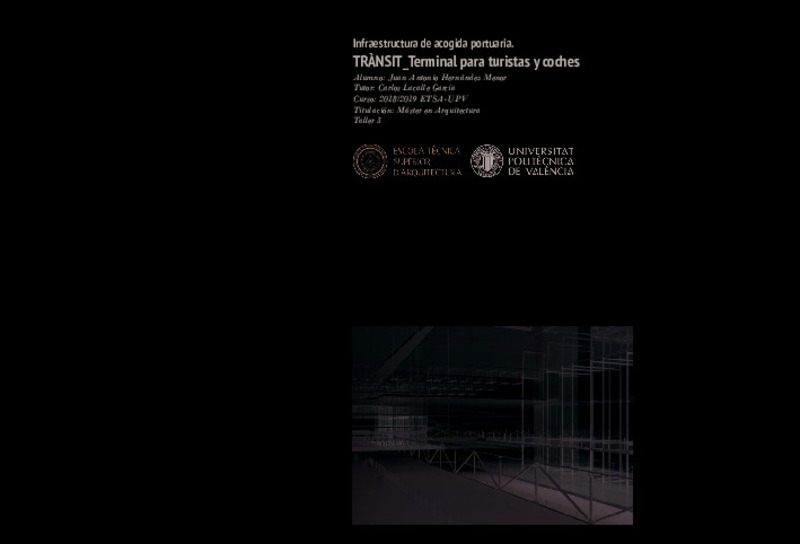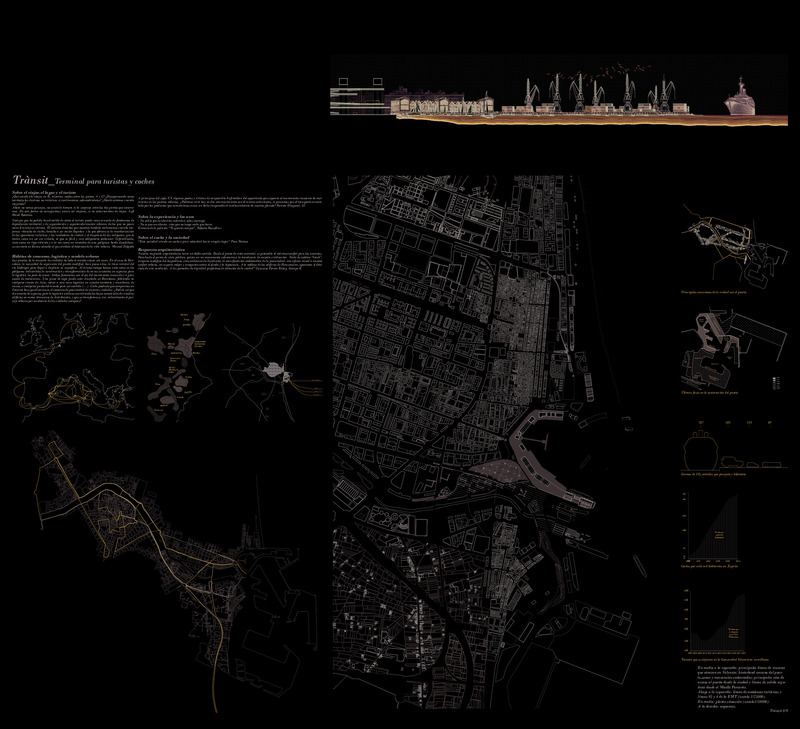JavaScript is disabled for your browser. Some features of this site may not work without it.
Buscar en RiuNet
Listar
Mi cuenta
Estadísticas
Ayuda RiuNet
Admin. UPV
Infraestructura de acogida portuaria : TRÀNSIT, terminal para turistas y coches
Mostrar el registro sencillo del ítem
Ficheros en el ítem
| dc.contributor.advisor | Lacalle García, Carlos
|
es_ES |
| dc.contributor.author | Hernández Menor, Juan Antonio
|
es_ES |
| dc.coverage.spatial | east=-0.32684326171875; north=39.45488422238185; name=Puerto Valencia, 46024 Valencia, Espanya | es_ES |
| dc.date.accessioned | 2020-06-09T12:57:59Z | |
| dc.date.available | 2020-06-09T12:57:59Z | |
| dc.date.created | 2019-05-21 | |
| dc.date.issued | 2020-06-09 | es_ES |
| dc.identifier.uri | http://hdl.handle.net/10251/145816 | |
| dc.description.abstract | [ES] La terminal para turistas y coches se plantea como una pieza clave en la articulación del nuevo entorno portuario. Por un lado, tiene la capacidad receptora de visitantes o turistas que llegan al final de su recorrido en barco y, por otro, funciona como un espacio donde finaliza el 'trànsit'* de coches de la ciudad. Un espacio de encuentro y cambio. La infraestructura se plantea como una serie de superficies que intentan ser generadoras de una primera reflexión al visitante que llega. Para provocar dicha introspección, la construcción se concibe como un recorrido prácticamente vacío de contenido, como si de una línea o un umbral se tratase, la cual divide a la persona que es (interior) y la ciudad en la que está (exterior). Borrando, de esta manera, posibles distracciones programáticas que puedan interferir en la continuidad espacial de este 'trànsit'. La arquitectura de las piezas no intenta resolver (o engañar sobre) la realidad física en la que se ha convertido la ciudad capitalista, o mejor dicho, lo que supone mantener un modelo urbano basado en el consumo. Por esta razón, se plantea como un itinerario en donde se puede apreciar el paisaje industrial que ha transformado el frente marítimo, al mismo tiempo que un escenario privilegiado y dominado por los coches. El movimiento de vehículos y personas sobre las rampas y plataformas alude al paisaje dinámico de mercancías y embarcaciones propio de entornos portuarios. Las grandes estructuras que sustentan los planos inclinados sobre las que circulan pasajeros y vehículos son una referencia a las grúas de carga y descarga de contenedores. Partiendo de la premisa de que el capitalismo se reformulará a sí mismo y hará desaparecer el automóvil de su ecuación vital para poder seguir sobreviviendo en un contexto amenazado por la contaminación del medio, la terminal se plantea como una futura gran arqueología industrial inerte que sirva a generaciones venideras para reflexionar sobre la patológica relación que en un pasado la sociedad tuvo con el coche. *Se utiliza el término en valenciano 'trànsit' ya que, a diferencia del castellano, engloba en una misma palabra los términos de paso de un espacio a otro; cambio de un estado a otro; y tráfico, circulación o movimiento. | es_ES |
| dc.description.abstract | [EN] The terminal for tourists and cars posits itself as a key piece in the articulation of the new harbor setting. On the one hand, it has a receiving capacity towards visitors or tourists who arrive at the conclusion of their sea journey, and on the other, it functions as a space where the 'trànsit'* of the city cars comes to an end. A space of encounter and change. The infrastructure is posited as a series of surfaces whose goal is generating a first reflection in the arriving visitor. In order to stimulate this reflection, the construction is conceived as a path with practically no contents, as if it was a line or threshold dividing the (inner) person who exists, and the (outer) city in which the person is situated. Erasing thus the potential programmatic distractions that could interfere in the spatial continuity of this 'trànsit'. The architecture of the pieces does not attempt to solve (or deceive with regard to) the physical reality the capitalist city has turned into, or in other words, all that a consumption-based urban model entails. For this reason, it is posited as an itinerary where one can appreciate the industrial landscape that has transformed the maritime front, as well as a stage favored and dominated by cars. The movement of vehicles and people on the ramps and platforms alludes to the dynamic landscape of goods and vessels, typical of harbor settings. The large structures supporting the inclined planes on which passengers and vehicles circulate are a reference to the cranes employed for the loading and unloading of containers. Starting from the premise that capitalism will reformulate itself, removing automobiles from its vital equation in order to endure in a context threatened by environmental pollution, the terminal is posited as something that will in time become a large and inert piece of industrial archaeology, stimulating in future generations a reflection on the pathological relationship that our bygone society used to have with cars. *The choice of the Valencian term 'trànsit' is due to the fact that, unlike the corresponding word in Spanish, it encompasses the following meanings: transition from one space to another; transformation from one state to another; and traffic, circulation or movement. | es_ES |
| dc.format.extent | 79 | es_ES |
| dc.language | Español | es_ES |
| dc.publisher | Universitat Politècnica de València | es_ES |
| dc.rights | Reserva de todos los derechos | es_ES |
| dc.subject | Infraestructuras portuarias | es_ES |
| dc.subject | Terminales portuarias | es_ES |
| dc.subject | Terminales para pasajeros | es_ES |
| dc.subject | Terminales para vehículos | es_ES |
| dc.subject | Infraestructuras de transporte marítimo | es_ES |
| dc.subject | Port facilities | es_ES |
| dc.subject | Port terminals | es_ES |
| dc.subject | Passenger terminals | es_ES |
| dc.subject | Vehicles shipping | es_ES |
| dc.subject | Cars shipping | es_ES |
| dc.subject | Marine transport infraestructure | es_ES |
| dc.subject | Harbors | es_ES |
| dc.subject | Docklands | es_ES |
| dc.subject | Valencia | es_ES |
| dc.subject | València | es_ES |
| dc.subject.classification | PROYECTOS ARQUITECTONICOS | es_ES |
| dc.subject.other | Máster Universitario en Arquitectura-Màster Universitari en Arquitectura | es_ES |
| dc.title | Infraestructura de acogida portuaria : TRÀNSIT, terminal para turistas y coches | es_ES |
| dc.type | Tesis de máster | es_ES |
| dc.rights.accessRights | Abierto | es_ES |
| dc.description.bibliographicCitation | Hernández Menor, JA. (2019). Infraestructura de acogida portuaria : TRÀNSIT, terminal para turistas y coches. http://hdl.handle.net/10251/145816 | es_ES |
| dc.description.accrualMethod | TFGM | es_ES |
| dc.relation.pasarela | TFGM\106975 | es_ES |
Este ítem aparece en la(s) siguiente(s) colección(ones)
-
ETSA - Trabajos académicos [4687]
Escuela Técnica Superior de Arquitectura







